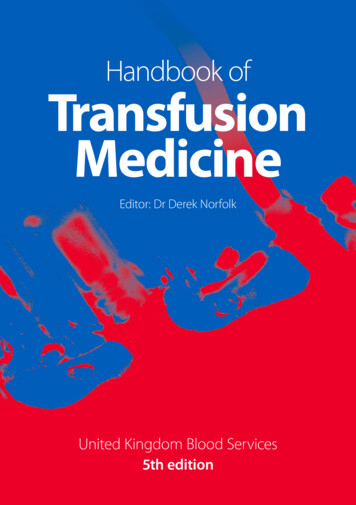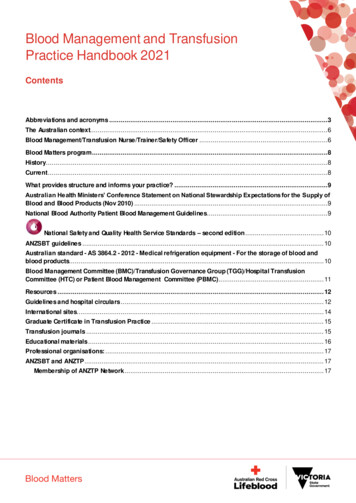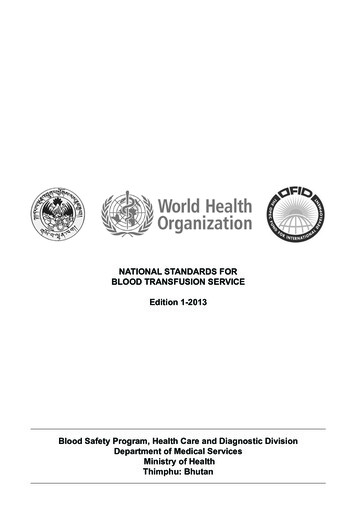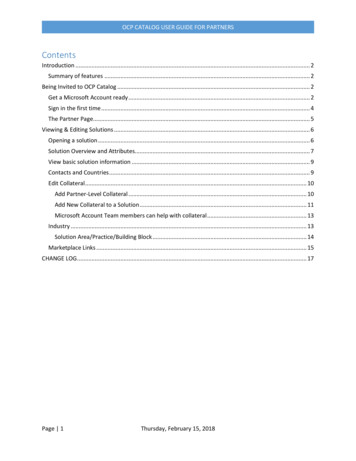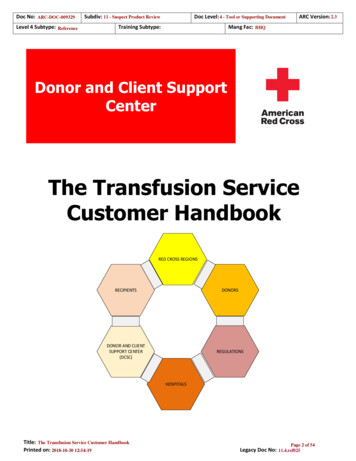
Transcription
Doc No:ARC-DOC-009329Level 4 Subtype:ReferenceSubdiv: 11 - Suspect Product ReviewDoc Level: 4 - Tool or Supporting DocumentTraining Subtype:Mang Fac:ARC Version: 2.3BHQDonor and Client SupportCenterThe Transfusion ServiceCustomer HandbookRED CROSS REGIONSRECIPIENTSDONORSDONOR AND CLIENTSUPPORT CENTER(DCSC)REGULATIONSHOSPITALSTitle: The Transfusion Service Customer HandbookPrinted on: 2018-10-30 12:54:19Legacy Doc No:Page 2 of 5411.4.ref025
Doc No:ARC-DOC-009329Level 4 Subtype:Subdiv: 11 - Suspect Product ReviewReferenceTraining Subtype:Doc Level: 4 - Tool or Supporting DocumentMang Fac:ARC Version: 2.3BHQTable of ContentsIntroduction.4Communications Overview.5Appendix I: Contact Information - Donor and Client Support Center.6Appendix II: Terminology .7Appendix III: Information about the Red Cross Website and Links .10Appendix IV: Screening Tests and Additional Test Results .13Appendix V: Descriptions of DCSC Communications.14Appendix VI: Descriptions of Regional Communications.23Appendix VII: Product Complaints and Order Discrepancies .24Appendix VIII: Recipient Testing.25Appendix IX: Frequently Asked Questions (FAQs) .26Appendix X: Sample Letters and Forms .28Title: The Transfusion Service Customer HandbookPrinted on: 2018-10-30 12:54:19Legacy Doc No:Page 3 of 5411.4.ref025
Doc No:ARC-DOC-009329Level 4 Subtype:Subdiv: 11 - Suspect Product ReviewReferenceTraining Subtype:Doc Level: 4 - Tool or Supporting DocumentMang Fac:ARC Version: 2.3BHQIntroductionBasic InformationThis handbook is designed to provide a basic overview on the exchange of information betweenyou (the customer) and the Donor and Client Support Center (DCSC).The DCSC is a consolidation of donor management and product notification activities which aremanaged in two central locations, Charlotte, NC and Philadelphia, PA.DCSC is responsible for interacting with hospital customers and other institutions that receiveblood products from the American Red Cross. These interactions include:! Communicating market withdrawal/recall/recipient traceback (lookback) notification activities! Processing reports of patient adverse reactions/possible transfusion-related infections(recipient complications)! Completing the required notifications and obtaining authorizations to referring physicians andtransfusions services for any autologous donations with reactive test results or any otherproduct suitability issuesThis exchange of communication can take place in the format of a letter, a form, and in somecases, a report. Because there is a variety in the types of communications received from or sentto the DCSC it is important that the terminology used and the purpose for those communicationsin each case is clearly understood.The appendices in the handbook provide supplemental information about Red Crosscommunications including common terms, a list of most frequently asked questions (FAQs) andsamples of completed letters and forms. Because we are constantly working to improve ourcommunications, these documents may change periodically and look different than the samplesprovided; however, the purpose for each document remains the same.Customer Contact InformationPlease note that in order to provide you with timely and efficient delivery of information it isimportant that DCSC has the correct contact information for your facility on file. Any change inthis contact information should be reported to the DCSC by email (DCSCmailbox@redcross.org)or fax (888-719-3535).Access to Handbook and Report FormsThis handbook, along with the recipient complication report forms, is available in both electronicor hard copy formats. See Appendix III for information about locating forms on the website.! For a printed copy, send a request via e-mail to DCSCmailbox@redcross.org.Title: The Transfusion Service Customer HandbookPrinted on: 2018-10-30 12:54:19Legacy Doc No:Page 4 of 5411.4.ref025
Doc No:ARC-DOC-009329Level 4 Subtype:ReferenceSubdiv: 11 - Suspect Product ReviewTraining Subtype:Doc Level: 4 - Tool or Supporting DocumentMang Fac:ARC Version: 2.3BHQCommunications OverviewTypes of CommunicationsDCSC issues a number of communications when new or updated information is received about aproduct that was shipped to a customer. The purpose of these communications is to notify youthat the suitability status of the product may have changed because of:! A market withdrawal due to test results! A retrieval or recall that has been triggered by information not related to test results! Information received that meets the criteria of a recipient lookback investigationOther types of letters or forms may be sent as well, including:! Notification or a request to authorize the release of an autologous unit! Information about a recipient complication case that was submitted for investigation! An annual letter used as a reminder to report recipient reactions to the Red CrossAppendix V provides detailed descriptions of the letters and forms sent by the DCSC, whileAppendix X contains samples of communications that may be issued by the DCSC under a varietyof situations. Each letter identifies the circumstances under which it is being sent and includesinformation regarding the identification of products received at your facility. All communicationsprovide a contact name, phone number, and email address in case you have questions about theinformation provided.Frequency of CommunicationsMore than one type of communication may be sent for the same product or issue. In some cases,the same communication may be issued more than once; the letter itself will explain why it hasbeen re-issued. Sometimes this occurs when a form included in the initial letter is not returned toDCSC with the requested information; in others it may be to inform you of a delay in obtainingfinal product or test status, to provide you with an update to the original communication, or toinform you of additional test results that have become available.At the end of Appendix V is a summary of the more common situations when a letter or form issent, the actions requested, and any follow-up that may be needed.Title: The Transfusion Service Customer HandbookPrinted on: 2018-10-30 12:54:19Legacy Doc No:Page 5 of 5411.4.ref025
Doc No:ARC-DOC-009329Level 4 Subtype:Subdiv: 11 - Suspect Product ReviewDoc Level: 4 - Tool or Supporting DocumentTraining Subtype:ReferenceMang Fac:ARC Version: 2.3BHQAppendix I: Contact Information - Donor and Client Support CenterManagement Team - OperationsTitleNameContactInformation (phone and email)ExecutiveDirectorJulie Hall704-805-3013Julie.Hall@redcross.orgSr. DirectorArtan agersSheila Bethea704-805-3191Sheila.Bethea@redcross.orgDonna Burke215-451-4892Donna.Burke@redcross.orgDebbie ky ical OfficersExecutiveMedical OfficersKathleen Grima, MD215-667-9039Kathleen.Grima@redcross.orgYvette Miller, MD704-805-3020Yvette.Miller@redcross.orgGeneral Contact Number866-236-3276 (ask for a supervisor)Fax: 888-719-3535Title: The Transfusion Service Customer HandbookPrinted on: 2018-10-30 12:54:19Email: DCSCmailbox@redcross.orgLegacy Doc No:Page 6 of 5411.4.ref025
Doc No:ARC-DOC-009329Level 4 Subtype:ReferenceSubdiv: 11 - Suspect Product ReviewTraining Subtype:Doc Level: 4 - Tool or Supporting DocumentMang Fac:ARC Version: 2.3BHQAppendix II: TerminologyAdditional Test ResultsFurther testing, including confirmatory or NAT discriminatory, performed on donation samplesthat are reactive for any infectious disease screening tests. Other testing may be performed toprovide additional information for donors, counselors, and physicians (for example, WNV PCRtesting).AutologousA person who is both the donor and the intended recipient; the collection of autologouscomponents requires a physician’s orderCustomerA facility that receives goods or services provided by the American Red CrossThe terms “customer,” “consignee,” and “client” are used interchangeably throughout thismanual.Gaining ControlA preliminary step in a component investigation; refers to the immediate actions taken to ensurethat in-date components are held or placed in quarantine until the investigation is completed.Gaining control is not a recallImplicated Donation/DonorA donor or a product that has been identified as the likely or certain cause of a recipientcomplication based on a Red Cross physician’s final case assessment of a transfusioninvestigationIndate (Component)A whole blood or blood component that has not reached the expiration date stated on the labelIndex Donation/SampleA sample from a donation that tests reactive by a specific screening assay and is used to triggerfurther investigationInvestigationAn inspection conducted “for cause” when there is reason to believe that a recipient complicationor a violation of a law, regulation, or facility standard operating procedure has occurredInvolved DonationA reported donation (sometimes referred to as index donation) that is part of an investigation, orcould have been the cause of a recipient complication based on the evaluation of a Red CrossphysicianLookback (Lookback/Traceback)The tracking and identification of the location and disposition of blood component products thatwere manufactured from donations by a particular donor; the steps taken to track and quarantineunsuitable blood or blood components and to notify consignees when a donor subsequently testspositive or provides information regarding a diagnosis for the most significant infectious diseasemarkersTitle: The Transfusion Service Customer HandbookPrinted on: 2018-10-30 12:54:19Legacy Doc No:Page 7 of 5411.4.ref025
Doc No:ARC-DOC-009329Level 4 Subtype:ReferenceSubdiv: 11 - Suspect Product ReviewDoc Level: 4 - Tool or Supporting DocumentTraining Subtype:Mang Fac:ARC Version: 2.3BHQMarket WithdrawalA firm’s removal or correction of a distributed product that involves a minor violation subject tolegal action by the Food and Drug Administration (FDA) or that involves no violation (forexample, normal stock rotation practices, or routine equipment adjustments and repairs)Nucleic Acid Testing (NAT)Method of testing that detects genetic material of the virus, such as hepatitis C virus (HCV),human immunodeficiency virus (HIV), hepatitis B virus (HBV), West Nile virus (WNV), and Zikavirus. Two types of NAT are the following:! Transcription mediated amplification (TMA) – the type of NAT that the Red Cross performsusing the licensed Ultrio HIV-1/HCV/HBV Assay. TMA is also used as a screening test for WNV! Polymerase chain reaction (PCR) – a type of NAT that is performed as a supplemental assayto confirm a reactive TMA resultReactiveFor viral testing, a sample that has both an initial and repeat reactive screening resultRecallA firm’s removal or correction of a marketed product that the FDA considers to be in violation ofthe laws it administers and against which the agency would initiate legal action (for example,seizure). Recall does not include a market withdrawal or stock recoveryRecipient ComplicationThe undesirable outcome of a blood transfusion; may be a transfusion-transmitted infection or atransfusion reactionRetrieval (Blood)A general term used for an action taken (such as a recall or market withdrawal) to removeunsuitable blood or blood components from the marketplaceScreening TestAn FDA-approved assay used to test a donation for evidence of infection due to communicableagentsTransfusion ReactionA recipient complication not related to an infection with a virus or similar transfusiontransmissible agents. Examples include transfusion related acute lung injury (TRALI), hemolyticreactions, and septic reactions.Transfusion ServiceA facility that performs one or more of the following activities:! Compatibility testing! Storage! Selection! Issuing of blood and components to intended recipientsThis facility routinely does not collect blood or process whole blood into components, except redblood cells and recovered plasma.The terms “transfusion service” and “health care facility” are used interchangeably.Title: The Transfusion Service Customer HandbookPrinted on: 2018-10-30 12:54:19Legacy Doc No:Page 8 of 5411.4.ref025
Doc No:ARC-DOC-009329Level 4 Subtype:ReferenceSubdiv: 11 - Suspect Product ReviewTraining Subtype:Doc Level: 4 - Tool or Supporting DocumentMang Fac:ARC Version: 2.3BHQTransfusion-Transmitted InfectionAn infection predominately acquired by the transfusion of a virus or a parasite, in which a delaygenerally occurs between transfusion and manifestation of the symptoms and signs of infection.The infection does not pertain to a septic transfusion reaction that is associated with the bacterialcontamination of a unit (See “Transfusion Reaction”).Unsuitable Blood or Blood ProductsBlood or blood components whose safety, purity, or potency ("quality") may have been affectedTitle: The Transfusion Service Customer HandbookPrinted on: 2018-10-30 12:54:19Legacy Doc No:Page 9 of 5411.4.ref025
Doc No:ARC-DOC-009329Level 4 Subtype:ReferenceSubdiv: 11 - Suspect Product ReviewTraining Subtype:Doc Level: 4 - Tool or Supporting DocumentMang Fac:ARC Version: 2.3BHQAppendix III: Information about the Red Cross Website and LinksThe Red Cross website contains a large amount of information for our donors, the public, and ourhospital customers. This appendix is not intended to be a tutorial for the website but only callsattention to those pages or links specifically referenced in the handbook or in a communicationsent to our customers.Accessing information useful to hospitals can be found by typing in the following address into theURL field: RedCrossBlood.org.The homepage displays. The appearance of this page will change on a routine basis so can bedifferent from what is shown below:!Note: using the former address www.redcrossblood.org will prompt a different page todisplay but accessing information from that point is the same, no matter which address isused.Using the mouse, click on the heading for Biomedical Services. A list of available options bycategory will then appear:Title: The Transfusion Service Customer HandbookPrinted on: 2018-10-30 12:54:19Legacy Doc No:Page 10 of 5411.4.ref025
Doc No:ARC-DOC-009329Level 4 Subtype:ReferenceSubdiv: 11 - Suspect Product ReviewTraining Subtype:Doc Level: 4 - Tool or Supporting DocumentMang Fac:ARC Version: 2.3BHQSelecting “Case Reports” from the Hospital Partners category takes you to a section that providesbasic information about the regulatory requirements for reporting an adverse transfusion reaction(referenced in Appendix V), and allows for the download of the two forms used in reporting thesereactions.Also under the Hospital Partners category is an option called Blood Bank Resources. Clicking onthis item provides electronic access to other items of interest, including the following:! Red Cross Infectious Disease Testing Methodologies (referenced in Appendix IV) whichincludes the screening method and type of confirmatory test, when one is available, for eachmarker! TRALI mitigation! Transfusion Service Customer Handbook (this document)Title: The Transfusion Service Customer HandbookPrinted on: 2018-10-30 12:54:19Legacy Doc No:Page 11 of 5411.4.ref025
Doc No:ARC-DOC-009329Level 4 Subtype:ReferenceSubdiv: 11 - Suspect Product ReviewTraining Subtype:Doc Level: 4 - Tool or Supporting DocumentMang Fac:ARC Version: 2.3BHQUnder the Blood and Diagnostic Testing category is a link to the Infectious Disease Testing usedby the Red Cross. Clicking on the plus symbol ( ) by each test listed expands the field to provideadditional resource information.A review of the lists under each category shows additional information that could present itself inone of our communications, or prove useful resource material, such as reimbursements, bloodproducts, molecular testing, and contact information.The website is also a source of information for blood donors, allowing them to review theeligibility requirements for donating blood, and providing them with a better understanding of thedonation process.Title: The Transfusion Service Customer HandbookPrinted on: 2018-10-30 12:54:19Legacy Doc No:Page 12 of 5411.4.ref025
Doc No:ARC-DOC-009329Level 4 Subtype:ReferenceSubdiv: 11 - Suspect Product ReviewDoc Level: 4 - Tool or Supporting DocumentTraining Subtype:Mang Fac:ARC Version: 2.3BHQAppendix IV: Screening Tests and Additional Test ResultsAmerican Red Cross Donation ScreeningThe Red Cross screens all donations for relevant transfusion-transmitted infections, according toall applicable regulatory requirements and guidance, including 21 CFR 610.40 and AABBstandards. When a donor sample is repeat-reactive (reactive) for a serologic screening test orreactive by NAT, samples are further tested using more specific tests (when available) to confirm,discriminate, or provide additional information about the screening result.This additional testing may be performed at one of several American Red Cross laboratories or byan approved outside vendor.Screening Test ResultsThe customer receives notification when the sample from a donor’s subsequent donation or froma donor’s current autologous donation is reactive for any of the following infectious diseasescreening tests:Hepatitis B surface antigen (HBsAg)Multiplex NAT for HIV-1/HCV/HBVAntibodies to hepatitis C virus (anti-HCV)Antibodies to hepatitis B core antigen(anti-HBc)Antibodies to human immunodeficiencyviruses (anti-HIV-1/HIV-2)West Nile virus (WNV)Antibodies to human T-cell lymphotropicvirus type I and type II (anti-HTLV-I/II)Antibodies to Trypanosoma cruzi(T. cruzi /Chagas)Serologic test for syphilis (STS)*Zika virus*Reactive syphilis tests are only reported on autologous donationsAs other infectious disease agents, such as babesia and dengue, become present in certaingeographic regions of the US and demonstrate to be transfusion transmitted, investigationalprotocols may be established so that testing for the disease agent can be performed.MethodologiesInformation about current test methods is available on our website in a pdf format titled RedCross Infectious Disease Testing Methodologies. Go to RedCrossBlood.org to locate thedocument or refer to Appendix III for help in locating the file.Title: The Transfusion Service Customer HandbookPrinted on: 2018-10-30 12:54:19Legacy Doc No:Page 13 of 5411.4.ref025
Doc No:ARC-DOC-009329Level 4 Subtype:ReferenceSubdiv: 11 - Suspect Product ReviewDoc Level: 4 - Tool or Supporting DocumentTraining Subtype:Mang Fac:ARC Version: 2.3BHQAppendix V: Descriptions of DCSC CommunicationsNon-Retrieval (Information only) OverviewSome communications are in an information-only category. Any actions you will be asked to takewill depend upon the reason for the communication. For example, you may be told that noactions on your part are needed or you may be asked to supply us with the status of the productor products sent to your facility. In the latter case, the letter will be accompanied by a form fordocumenting the product status (disposition).A. Gain Control RequestsA notification that products distributed to you are now under investigation; the reasons behind aninvestigation vary widely. You will be asked to quarantine the indate products pendingcompletion of the investigation, at which time you will be notified as to whether the product isacceptable for release or must be retrieved (discarded).B. Consignee Notification LetterSent when distributed products are the subject of a notification action that falls short of marketwithdrawal or product retrieval, such as:! A reported of diagnosis of West Nile virus! Rh type discrepancy! Red cell antigen typing discrepancyTitle: The Transfusion Service Customer HandbookPrinted on: 2018-10-30 12:54:19Legacy Doc No:Page 14 of 5411.4.ref025
Doc No:ARC-DOC-009329Level 4 Subtype:ReferenceSubdiv: 11 - Suspect Product ReviewDoc Level: 4 - Tool or Supporting DocumentTraining Subtype:Mang Fac:ARC Version: 2.3BHQMarket Withdrawals and Recalls (Overview)The retrieval process is intended to account for all components deemed unsuitable per Red Crossand FDA regulations whether from testing done on a subsequent donation by the donor or fromother sources of information. In some cases the letter will ask that you supply us with the statusof the product or products sent to your facility and include a product disposition form.C. Product Retrieval LetterSent when distributed products are the subject of a retrieval action not associated with routinetesting performed by the Red Cross. Retrievals include recalls and market withdrawals.D. Product Disposition FormIncluded in some communications in order to provide DCSC with information most routinelyasked for by the Food and Drug Administration (FDA) regarding the final status of the product(issued, discarded, transferred, etc.).E. Cover Letter for Non-Red Cross Product RetrievalSent to customers when distributed products collected by a non-Red Cross blood center are thesubject of a retrieval action (including market withdrawal and recall) or for a notification.F. Test Result Reactive – Market Withdrawal LetterSent when prior in-date components are subject to biologic market withdrawal due to asubsequent reactive screening test. The purpose is to retrieve in-date components which havenot been transfused and provide the reason for the withdrawal.G. Test Result – Follow-up Notification LetterSent when further testing has been completed subsequent to the initial retrieval notification;reported as follow-up testing to the specific screening test.! In the case when a confirmatory result triggers a “Recipient Lookback”, the follow-up to theinitial retrieval will be communicated to you by way of a letter for that specific purpose.! If the result is positive for a particular test, a reminder will be included in the letter that if thepatient is diagnosed with the underlying pathogen/infection, the case must be reported to usas a potential transfusion-transmitted infection so that a full investigation is performed.H. Positive Bacterial Detection First NotificationSent when distributed products are the subject of an investigation that is due to a positivebacterial quality control testI. Positive Bacterial Detection Follow-Up NotificationSent when a final determination has been made about the products involved in the investigationof a positive bacterial quality control testTitle: The Transfusion Service Customer HandbookPrinted on: 2018-10-30 12:54:19Legacy Doc No:Page 15 of 5411.4.ref025
Doc No:ARC-DOC-009329Level 4 Subtype:ReferenceSubdiv: 11 - Suspect Product ReviewTraining Subtype:Doc Level: 4 - Tool or Supporting DocumentMang Fac:ARC Version: 2.3BHQRecipient Lookback (Lookback/Traceback) Notifications (Overview)A recipient investigation is conducted to notify individuals who may have been exposed to atransfusion-transmissible disease from a blood transfusion. These investigations are mostcommonly initiated subsequent to market withdrawal, and when the confirmatory test is positivefor one of the following:! Anti-HIV-1! Anti-HIV-2! HIV NAT! Anti-HCV! HCV NAT! T. cruzi antibody (Chagas)! Other positive markers for infectious disease determined to be medically significant by theRed Cross Biomedical Services Headquarters (BHQ) Medical OfficeFederal regulations also require recipient lookback investigations in cases when the donor’s bloodsample is:! Reactive for NAT multiplex (HIV-1/HCV/HBV) but there is no supporting evidence todiscriminate to one of the underlying pathogens! Reactive for the HIV antibody screening test but a confirmatory test is not performed! Reactive for the HCV antibody screening test but a confirmatory test is not performedA recipient investigation would also be conducted immediately upon receipt of evidence that thedonor of a distributed unit of blood now has an infection involving one of the above pathogens,including:! A written report of a recipient having a positive infectious disease test result! A written report from a reliable external source that a recipient has a positive test, is ill with,or has died from an associated disease! A written report or verbal report from a reliable source that a recipient experienced atransfusion reaction! Verification from the facility physician/designee that a verbal report is from a reliable source(a written report would be requested)! When a recipient identified through an investigation is found to be confirmed positive andother transfused products may be involvedPlease note that our term “lookback/traceback” or “traceback,” describes what the Code ofFederation Regulations (CFR) refers to as “’lookback” in 21 CFR 610.46, 21 CFR 610.47, alongwith other FDA guidance documents and AABB standards. Unlike market withdrawals, lookbackinvestigations bring specific requirements for recipient tracing and notification, including but notlimited to:!!!!Notifying the transfusion recipients of previous collections of blood and blood components atincreased risk of a transmitted infectionNotifying the recipient's physician of record of the need for recipient testing and counselingNotifying the recipient's physician of record or a legal representative or relative if therecipient is a minor, deceased, or adjudged incompetent by a State courtMaking reasonable attempts to perform the notification within 12 weeks after receiving thesupplemental (additional, more specific) test results for evidence of infection from thecollecting establishment, or after receiving the donor's reactive screening test result if thereis no available supplemental test that is approved for such use by the FDATitle: The Transfusion Service Customer HandbookPrinted on: 2018-10-30 12:54:19Legacy Doc No:Page 16 of 5411.4.ref025
Doc No:ARC-DOC-009329Level 4 Subtype:ReferenceSubdiv: 11 - Suspect Product ReviewTraining Subtype:Doc Level: 4 - Tool or Supporting DocumentMang Fac:ARC Version: 2.3BHQJ. Traceback Notification Subsequent to Market WithdrawalSent when a recipient lookback investigation is being conducted subsequent to marketwithdrawal.K. Traceback Notification to Transfusion ServiceSent when a recipient lookback investigation is being conducted independent of Red Cross testingor a prior market withdrawal.L. Recipient Status FormSent when the unit has been identified as transfused or the unit’s status is not yet known; theinformation requested on the form is to help with determining whether the scope of theinvestigation needs to be expanded based on any testing performed on the recipients. (See alsoAppendix VIII, Recipient Testing.)M. Traceback Follow-Up RequestSent when a response has not been received from the customer after a period of days followingthe initial notification.Title: The Transfusion Service Customer HandbookPrinted on: 2018-10-30 12:54:19Legacy Doc No:Page 17 of 5411.4.ref025
Doc No:ARC-DOC-009329Level 4 Subtype:ReferenceSubdiv: 11 - Suspect Product ReviewTraining Subtype:Doc Level: 4 - Tool or Supporting DocumentMang Fac:ARC Version: 2.3BHQAutologous Notifications (Overview)The FDA and AABB require that referring physicians and transfusion services (other than thecollection site) be notified when a unit tests reactive for a transfusion-transmitted disease.The FDA further requires that under certain circumstances (such as reactive HIV, HIV NAT, andHBsAg test results) autologous components be distributed only with written, dated, and signedauthorization from the patient’s physician. In addition, the Red Cross requires that thetransfusion services also authorize shipment of these units to their facility.Regulatory RequirementsThe CFR and AABB standards require that all blood collection facilities inform the referringphysician of the following:! When an autologous donor is deferred from allogeneic donation based on a test result, andwhich test result caused the deferral! When appropriate, the types of donations that the autologous donor should not give in thefuture! Additional, more specific test results performed on the autologous donationNotifications and authorizations must be communicated in writing. All notifications for additionaltest results must be complete within 8 weeks of the reactive test result.N. Autologous Notification and Authorization FormWhen a notification only is sent (authorization for the release of the autologous blood product isnot required), no further action is needed.When you’ve been informed that a signed authorization is required on the autologous notificationand authorization form, then! Complete the fields in the Transfusion Service section for name and title! Sign and date the appropriate line that indicates your acceptance of or refusal to accept theunit! Return the form to the DCSCSpecial Note on AuthorizationsIf the autologous test result requires a signed Authorization for Release from both the physicianand the transfusion service, a form signed by both parties MUST be received prior to shipment ofthe component.Physicians may change hospital locations for the surgery. In this case, a signed autho
Access to Handbook and Report Forms This handbook, along with the recipient complication report forms, isavailable in both electronic or hard copy formats. See Appendix IIIfor informationabout locating forms on the website.! For a printed copy, send a request via e-mail to DCSCmailbox@redcross.org. Page 4 of 54File Size: 2MB
